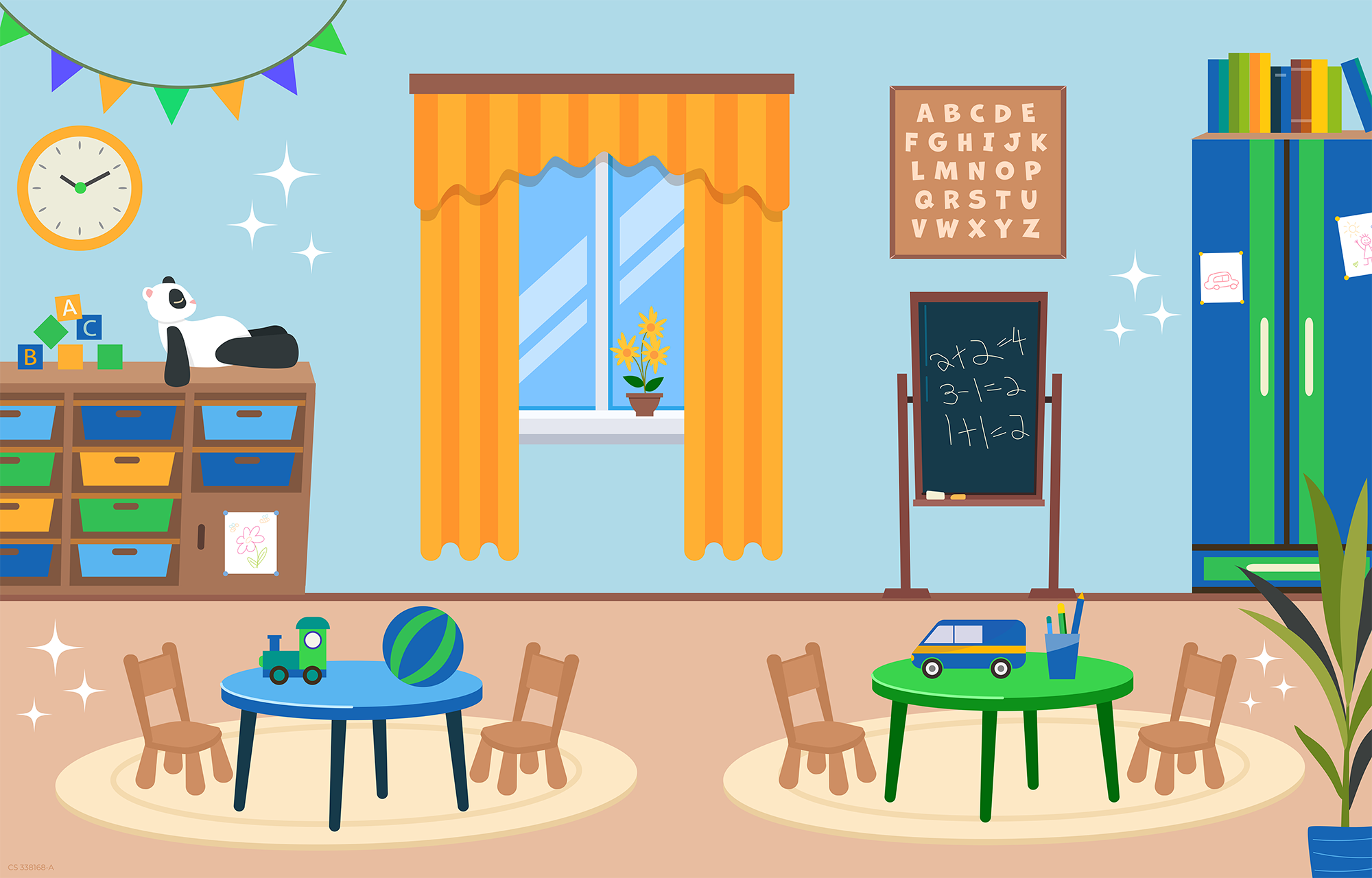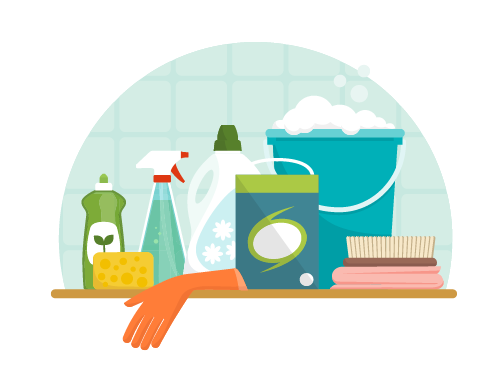Key points
- Keeping early care and education (ECE) settings clean helps prevent harmful germs from spreading among children and staff.
- Staff in ECE settings should clean surfaces regularly and follow recommended procedures for cleaning, sanitizing, and disinfecting after activities such as diapering, feeding, and contact with body fluids.

Terms to know
- Cleaning is done with soap, water, and scrubbing. Cleaning removes germs, dirt, and impurities from surfaces. Cleaning alone can remove most types of harmful germs (like viruses, bacteria, parasites, or fungi).
- Sanitizing reduces the number of germs on surfaces to levels public health codes or regulations consider safe. Sanitizing is done with weaker bleach solutions or sanitizing sprays. Clean surfaces before you sanitize them. Sanitize surfaces that come in contact with children's mouths, such as infant feeding items and toys.
- Disinfecting is done with stronger bleach solutions or other chemical products. These chemicals destroy any remaining germs on surfaces after cleaning. Clean surfaces before you disinfect them. Disinfect surfaces when someone is sick or at higher risk of getting sick.

Consider the type of surface and how often it is touched. Generally, high-touch surfaces (for example, tabletops, doorknobs and handles, toys) are more likely to have germs on them. If the area is used often, you may choose to clean it more often or disinfect it in addition to cleaning.
Cleaning
It's important to follow standard cleaning procedures. To clean surfaces, use a product that is suitable for each surface and follow the instructions on the product label.
Clean visibly dirty surfaces, including lunch tables or craft areas. Clean daily, after a meal or activity.
For hard surfaces, such as certain toys, high-chair trays, and floors:
- Clean surfaces with soap and water or with cleaning products appropriate for use on these surfaces.
For soft surfaces such as clothing, cloth toys, and rugs:
- Clean the surface with cleaning products appropriate for use on these surfaces.
- Launder items (if possible) according to the manufacturer's instructions. Use the warmest appropriate water setting and dry items completely.
- Vacuum surfaces, such as carpets and rugs, and dispose of the dirt safely.
Sanitizing
When to sanitize
You may need to sanitize some surfaces and objects after each use.
- Sanitize objects and surfaces that an infant or child may use, such as infant feeding items, toys, and play surfaces.
- Sanitize surfaces using a product suitable for each surface, following instructions on the product label.
How to sanitize safely
You may not need to sanitize surfaces and objects daily if they are cleaned carefully after use. To sanitize a surface or object, use a weakened bleach solution, an EPA-registered sanitizing spray, or a dishwasher.
For cloth materials, such as bibs, placemats, napkins, and tablecloths:
- Launder or wash, rinse, and sanitize after each meal.
- Sanitize fabric articles by machine-washing and drying them after each use.
For nonporous objects, such as certain toys and infant feeding items:
- Sanitize items by either boiling, steaming, or using a weakened bleach solution. Check with the item's manufacturer about which method to use. A dishwasher with a sanitizing cycle can be used for some items.
- After sanitizing, place items on a clean, unused dish towel or paper towel and allow to air dry completely before storing or using.
- Use only clean dish towels to pat items dry to avoid transferring germs to the items.
Get more information on how to sanitize infant feeding items.
For hard surfaces, such as highchair trays, plates, and food preparation areas:
- Clean highchair trays, plates, and countertops with hot, soapy water.
- Wash, rinse, and sanitize highchair trays just before and right after they are used for eating.
- Children who eat at tables should have disposable or washed and sanitized plates for their food.
- Sanitize any surface that has been touched or contaminated, using sanitizing products.
Get more information on food safety.
What is a weakened bleach solution?
A weakened bleach solution is bleach diluted in water. If you cannot boil or steam items to sanitize them, consider using a weakened bleach solution.
- Prepare a bleach solution of 1 tablespoon of unscented bleach per gallon (16 cups) of water in a clean wash basin.
- Put items completely underwater. Make sure the solution touches all parts and there are no air bubbles.
- Soak items for at least 2 minutes.
- Remove with clean hands or tongs. Do not rinse because germs could get back onto the sanitized items. Any remaining bleach will break down quickly as it dries and will not hurt children.
Get more information on sanitizing with bleach.
Disinfecting
When to disinfect
Some areas in early care and education settings, such as bathrooms and diaper changing tables, should be regularly disinfected.
Immediately clean surfaces and objects that are visibly soiled. If surfaces or objects are soiled with body fluids or blood, use gloves and other standard precautions to avoid coming into contact with the fluid. Remove the fluid and then clean and disinfect the surface.
Use disinfecting wipes on electronic items that are touched often, such as phones and computers. Pay close attention to the directions for using disinfecting wipes. You may need to use more than one wipe to keep the surface wet for the stated length of contact time. Follow manufacturer's instructions and recommendations for cleaning electronics. Use disinfectant products safely.
To disinfect, clean the surface with soap and water first. Then use an EPA-registered disinfecting product or a diluted bleach solution.
Follow these important safety guidelines when using chemical disinfectants:
- Always read and follow the directions on the product label to make sure you use and dispose of it safely.
- Leave the disinfectant on the surface long enough to kill the germs. This is referred to as the "contact time." You can find the contact time in the directions. The surface should stay wet during the entire contact time to make sure germs are killed.
- Wear the recommended protective equipment (for example, gloves or goggles) to protect your skin and eyes from potential splashes.
- Do not mix cleaners and disinfectants unless the labels indicate it is safe to do so. Combining certain products (such as chlorine bleach and ammonia cleaners) can result in serious injury or death.
- Ensure good ventilation if using products indoors. For example, use a fan or open windows and doors to allow fresh air to enter.
- Ensure that custodial staff, teachers, and others who use cleaners and disinfectants read and understand all instruction labels for safe and appropriate product use.
- Store and use chemicals out of reach of children.
- Immediately after disinfecting, wash your hands with soap and water for 20 seconds.
Caution!
Handle waste properly
- Follow your facility's standard procedures for handling waste, which may include wearing gloves.
- Place no-touch waste baskets where they are easy to use. Throw disposable items used to clean surfaces and items in the trash immediately after use.
- Avoid touching used tissues and other waste when emptying waste baskets.
- Wash your hands with soap and water after emptying waste baskets and touching used tissues and similar waste.
